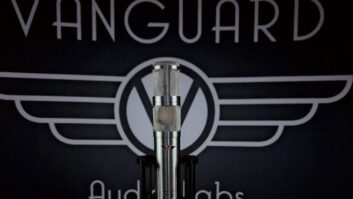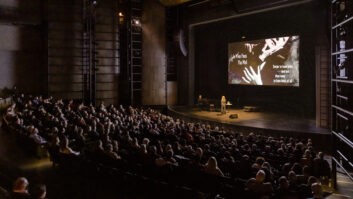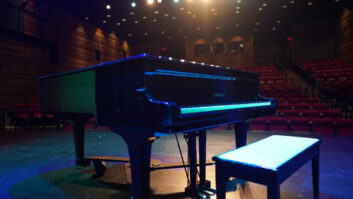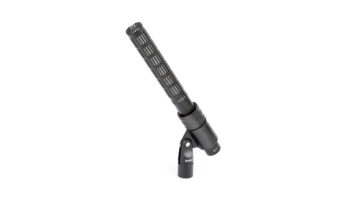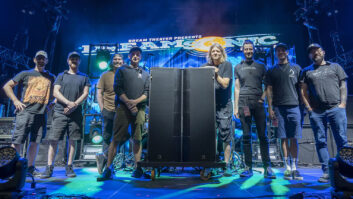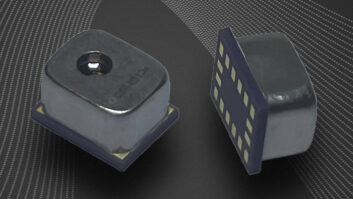The famed La Jolla Playhouse at the University of California, San Diego has been using a slew of DPA 2011C twin diaphragm cardioids as foot mics. Sir Winston Churchill’s famous comment about blood, sweat and tears not only symbolizes the effort that goes into any theatrical production but also represents a short list of just some of the challenges that may typically be encountered by microphones used in that environment. As if that weren’t enough, microphones in theatrical applications must often also be impervious to the vagaries of the wireless frequency spectrum, endure hours of constant use and be nearly invisible. Oh, and they had better sound great, too.

Speaking of blood, Carrie: The Musical, based on Stephen King’s bestselling novel, features a bucket of it, in the infamous prom scene familiar to anyone who has read the book or seen the movie. At the musical’s west coast premiere at The Victoria Theatre in San Francisco in late 2013, the actor playing Carrie had four gallons of fake blood dumped on her at every performance.
San Francisco-based Sound Productions supplied 21 Countryman E6i omnidirectional earset microphones as part of the sound design and engineering services that the company provided to the production. Anton Hedman, general manager of Sound Productions and owner of Hedman Sound, reports that one E6i was hidden in Carrie’s tiara for the prom scene. “We positioned the mic face down and protected it with a simple funnel-shaped wrap of medical tape around the capsule and a solid wrap around the ear connection in order to repel most of the liquid. We were all amazed at how well it worked!”
Hedman comments, “In my experience, Countryman E6i and B6 microphones are the best in their class and have terrific sound quality for theatrical applications. Because the E6i is so small, flexible and available in a variety of skin tones, it is remarkably easy to conceal on the talent, which is a key consideration for theatrical use. They are barely even noticeable when mounted directly against the face. And actors love them because they hardly notice they’re wearing a mic.”
Anton Hedman, general manager of Sound Productions, shows a Shure UR1 beltpack and Countryman E6i omnidirectional earset microphone used on Carrie The Musical.

He adds, “We typically use these mics with Shure SLX, ULX, UR and ULXD wireless systems and, together, they make a great combination.”
Carl Casella, sound designer at Sound Associates, a sound equipment rental and sales house with locations in the New York City area that serves live theater clients, is also a fan of Shure’s ULX-D system. Casella recently wrapped a production of A Night with Janis Joplin at the Lyceum Theater on Broadway.
“In the [radio spectrum] space of three conventional microphones, you can fit 32 of their digital ones,” says Casella of the ULX-D digital wireless system. Having used it on the show’s regional tour, he says, he was adamant about retaining the system for its Broadway run.
“It was so reliable and so bulletproof. I said, I just want to stay with the ULX. In New York, we added all the guitars on it also,” he says. “It’s served me well for 18 months without a problem.”
Casella is especially impressed by the longevity of the system’s lithium-ion rechargeable batteries. As he learned when he called Shure for replacements after using them on the production for a year, the batteries are actually good for several times that duration.
“The Shure guy told me, ‘They’re smart batteries—forget it. You’ve got at least two more years on them. You don’t need new ones; they’ll tell you when you’re getting close to needing new batteries.’ So we used the old batteries and haven’t had a moment’s worth of trouble,” Casella reports. “You don’t even have to take the batteries out of the mics—the mics drop into the chargers with the batteries in them.”
Since its founding in 1947, La Jolla Playhouse, a storied complex of theaters located on the campus of the University of California, San Diego, has reportedly produced 44 world premieres, 24 west coast premieres and seven U.S. premieres, reportedly sending more shows to Broadway than all other theaters in the country combined. Serving as both teaching facilities for the school’s dramatic arts students and as a venue for professional productions, the Playhouse acquired a selection of DPA Microphones during 2013, including 2011C twin diaphragm cardioids and 4061/4062 omni-directional miniature mics.
According to Joe Huppert, sound and video supervisor for the UCSD department for theater and dance and the La Jolla Playhouse, the venue often works with Broadway sound designers on the premiers of new productions. “They always expect us to have DPA microphones,” he reports.
Huppert continues, “We look for a realistic, somewhat intimate, sound reinforcement environment where we need high-quality sound rather than high levels of sound. All of the DPA mics that I’ve encountered have filled these needs.”
The DPA mics are typically deployed as foot mics and on instruments at the Playhouse. “We’ve used some other brands as foot mics, but we found them to be much more difficult to EQ and get a good sound,” says Huppert. “When we throw in a really good mic, like DPA, it makes it easier for us to teach our students how to get a good production.”
According to Eric Stahlhammer, the theater’s sound designer and owner of Greater Sound Designs, “The DPA mics are just way better in terms of flatter response, full coverage and off-axis response.”
When he elected to use the 2011C model for the Second City Comedy Troupe, says Stahlhammer, “We didn’t have an issue with feedback and what was going into the microphone was clean from the PA.” Having previously evaluated it against the DPA 4021 compact cardioid for use as a foot mic, he comments, “We ultimately selected the 2011C because we saw it as an interesting option that was great for this application because of its tighter pattern.”
David Hallock, production manager at the Park City School District’s Eccles Center for the Performing Arts, in Park City, UT, oversaw the purchase of a sizable Lectrosonics system last fall, including three Venue mainframe systems seen here.

Mindful of the impending FCC auction that could soon see wireless mic users moved out of the 600 MHz frequency spectrum, David Hallock, production manager at the Park City School District’s Eccles Center for the Performing Arts, in Park City, UT, recommended the purchase of a Lectrosonics system in fall 2013. The center purchased 18 Lectrosonics LMa beltpack transmitters, six HH handheld transmitters, three Venue mainframe systems fully loaded with VRS receiver modules, and a pair of ALP650 LPDA antennas.
“The very narrow band transmission capabilities of the transmitters, along with the rock-solid stability of the company’s Digital Hybrid Wireless system, made this equipment the ideal choice for futureproofing ourselves against the expected sale of the 600 band of wireless spectrum,” says Hallock. “From an audio quality perspective, Lectrosonics’ lack of companding offers truly uncolored audio performance and excellent response.”
The system proved its value during a student revival of the popular 1960 musical Bye Bye Birdie, when it was used in combination with the center’s existing RF equipment. “We were able to run 36 channels for two and a half weeks with absolutely no dropouts. The LMa transmitters held up to everything the students had to offer—without so much as a scratch,” he reports.
“The extremely flat frequency and phase response of the Digital Hybrid Wireless system made for a very high feedback threshold,” Hallock also comments. “Given that we had 34 mics on the deck at one time, this was a huge benefit. At one point, we had two lead characters standing directly in front of the house mains having an intimate conversation, and we had no problem getting enough level for them to be heard. Combine that with Lectrosonics’ almost non-existent noise floor, and the mix was greatly simplified.”


